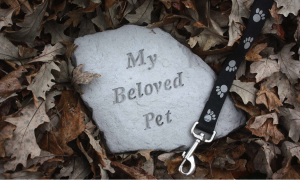DAWS Cat Whisperer: Meet Adriane
Every day, the cats in the DAWS cattery spend time with a very special person—DAWS own “cat whisperer.” Adriane Lechner is the Cattery Supervisor, and she creates a special bond with the cats that temporarily call DAWS home. She connects with them in a way that many others can’t, bringing the most shy and temperamental cats out of their shells so that one day they can find their forever homes. In honor of Adopt-a-Cat month, we wanted to honor the woman who truly makes a difference in the lives of the cats at DAWS.
DAWS: How long have you been working at DAWS?
Adriane: 10 ½ years
DAWS: What brought you to DAWS?
Adriane: I hated my prior job. I worked in retail, and learned pretty quickly that was NOT where I wanted to be.
DAWS: What are your primary responsibilities at DAWS?
Adriane: Managing the cattery. That would include day-to-day tasks such as feeding, cleaning, medicating, socializing, evaluating, and monitoring daily health of the cats as well as overarching duties such as intakes, inventories, donations, emails. I have my hands into everything!
DAWS: What do you find most rewarding about your job?
Adriane: My strongest talent is reading into cat behaviors and being able to adjust to their needs as best as I can. Sometimes, I can get really detailed with this, from understanding the bed a cat prefers to their placement within the room.
DAWS: Anyone who knows you says you are a cat whisperer. What are some of the ways that you connect with the cats in the cattery?
Adriane: As an introvert, I tend to avoid human contact as much as possible. This has lead me to develop a greater connection with animals, and cats specifically are what I’ve had most of my life. I’m with them 8 hours a day, 5 days a week and in that time they tell me quite a lot through observation alone. I make it my priority to make their stay at DAWS as stress free as possible and therefore becoming more adoptable.
DAWS: Do you have a special story about a cat that has been in our shelter that really touched your heart?
Adriane: I have too many of these! From Suzie to Buttercup to Reed, Mama Mustache (Loretta Lynn), Gem to Taco (Carissa) to Waffles and many, many more.
DAWS: Do you have a favorite cat in the cattery now? What is so special about that cat?
Adriane: A majority of my favorite cats have been donned the nickname “Monkey”. It’s usually reserved for younger, bratty tuxedo females. Waffles was my last monkey, but I await my next one!
DAWS: What would you like everyone to know about shelter cats/about adopting cats?
Adriane: The most difficult cats are the most rewarding. I have nothing but high praise for those who see through their tough exteriors and socialize and adopt some of our harder cases.
DAWS: What inspires you about working for DAWS?
Adriane: I always look forward to what kinds of personalities we may find from the animals we can help next. I’m here for all of them! ♥

 settle in a bit, our Dog Program Chair and Dog Trainer got the chance to evaluate her. She’s a sweet girl, who is just finding it a bit difficult to adjust to her new surroundings. None the less, she loves to play with her canine companions. She has a list of friends with whom she loves to romp in the yard. With their help, she is coming out of her shell and is even getting pets and love from the humans who arrange her play dates. She runs and chases her pals, plays with toys, and stops for a quick treat and a pet from the volunteers. Daffodil even flirts with her new “boyfriend,” Amos, who she is hoping to get to play with one day. Her sweet demeanor is shining through, and we know that one day a patient family (hopefully with a doggie pal already at home) will come along and give her a chance for a forever home.
settle in a bit, our Dog Program Chair and Dog Trainer got the chance to evaluate her. She’s a sweet girl, who is just finding it a bit difficult to adjust to her new surroundings. None the less, she loves to play with her canine companions. She has a list of friends with whom she loves to romp in the yard. With their help, she is coming out of her shell and is even getting pets and love from the humans who arrange her play dates. She runs and chases her pals, plays with toys, and stops for a quick treat and a pet from the volunteers. Daffodil even flirts with her new “boyfriend,” Amos, who she is hoping to get to play with one day. Her sweet demeanor is shining through, and we know that one day a patient family (hopefully with a doggie pal already at home) will come along and give her a chance for a forever home. Fox spent most of his time in his early days at DAWS hunkered down in a covered cat condo inside of his cage, not letting anyone touch him. Staff members covered his hiding spot with blankets to give him a sense of security while he settled in. As he became more accustomed to his surroundings, staff and volunteers began to socialize with him using string toys that he could swat from a distance. Their efforts have paid off, and slowly, but surely Fox is beginning to come out of his shell.
Fox spent most of his time in his early days at DAWS hunkered down in a covered cat condo inside of his cage, not letting anyone touch him. Staff members covered his hiding spot with blankets to give him a sense of security while he settled in. As he became more accustomed to his surroundings, staff and volunteers began to socialize with him using string toys that he could swat from a distance. Their efforts have paid off, and slowly, but surely Fox is beginning to come out of his shell. Fox has made great progress since first arriving at DAWS. He is venturing out of his cage, watching other cats play from a distance and meowing in response to their actions. He is beginning to accept pets from volunteers, even purring in response to the attention. With patience, dedication, and love, Fox will gain more confidence and become more comfortable in his surroundings. We know that he will come to understand that humans aren’t so bad after all, and one day he will find a loving family and a forever home.
Fox has made great progress since first arriving at DAWS. He is venturing out of his cage, watching other cats play from a distance and meowing in response to their actions. He is beginning to accept pets from volunteers, even purring in response to the attention. With patience, dedication, and love, Fox will gain more confidence and become more comfortable in his surroundings. We know that he will come to understand that humans aren’t so bad after all, and one day he will find a loving family and a forever home. Tessa has already been through a lot in her short life. She’s had puppies, become homeless, and made a long journey to a new state in hopes of finding happiness with a loving family. When Tessa arrived at DAWS, it was clear that she would make a family very happy one day. Her sweet demeanor, happy-go-lucky attitude, endless spunk, and absolutely adorable little face make her irresistible. But finding a home for Tessa was put on hold when her heartworm test came back positive. Tessa was facing another challenge that was standing in the way of a happy “forever” with a family of her own.
Tessa has already been through a lot in her short life. She’s had puppies, become homeless, and made a long journey to a new state in hopes of finding happiness with a loving family. When Tessa arrived at DAWS, it was clear that she would make a family very happy one day. Her sweet demeanor, happy-go-lucky attitude, endless spunk, and absolutely adorable little face make her irresistible. But finding a home for Tessa was put on hold when her heartworm test came back positive. Tessa was facing another challenge that was standing in the way of a happy “forever” with a family of her own. Through it all, Tessa remained a sweet and happy-go-lucky girl. Now that her treatment is completed, she is finally ready for the next chapter in her life—going home with a loving family.
Through it all, Tessa remained a sweet and happy-go-lucky girl. Now that her treatment is completed, she is finally ready for the next chapter in her life—going home with a loving family. your pet is able to exercise. The vet will screen for heart and lung problems and will check to make sure there are no musculoskeletal issues to consider. Your vet will also help you determine what type of an exercise regimen is right for your dog.
your pet is able to exercise. The vet will screen for heart and lung problems and will check to make sure there are no musculoskeletal issues to consider. Your vet will also help you determine what type of an exercise regimen is right for your dog. Children also experience grief, although they don’t always process their loss in the same way as adults. For kids, the first loss they may experience is the death of a beloved pet. Breaking the news that a pet has died can be a subject parents
Children also experience grief, although they don’t always process their loss in the same way as adults. For kids, the first loss they may experience is the death of a beloved pet. Breaking the news that a pet has died can be a subject parents  Parents can help children cope with loss by offering support. Allow kids to grieve. Let them be involved in a ‘funeral’ or memorial. If they express a need to say goodbye, allow them.
Parents can help children cope with loss by offering support. Allow kids to grieve. Let them be involved in a ‘funeral’ or memorial. If they express a need to say goodbye, allow them.